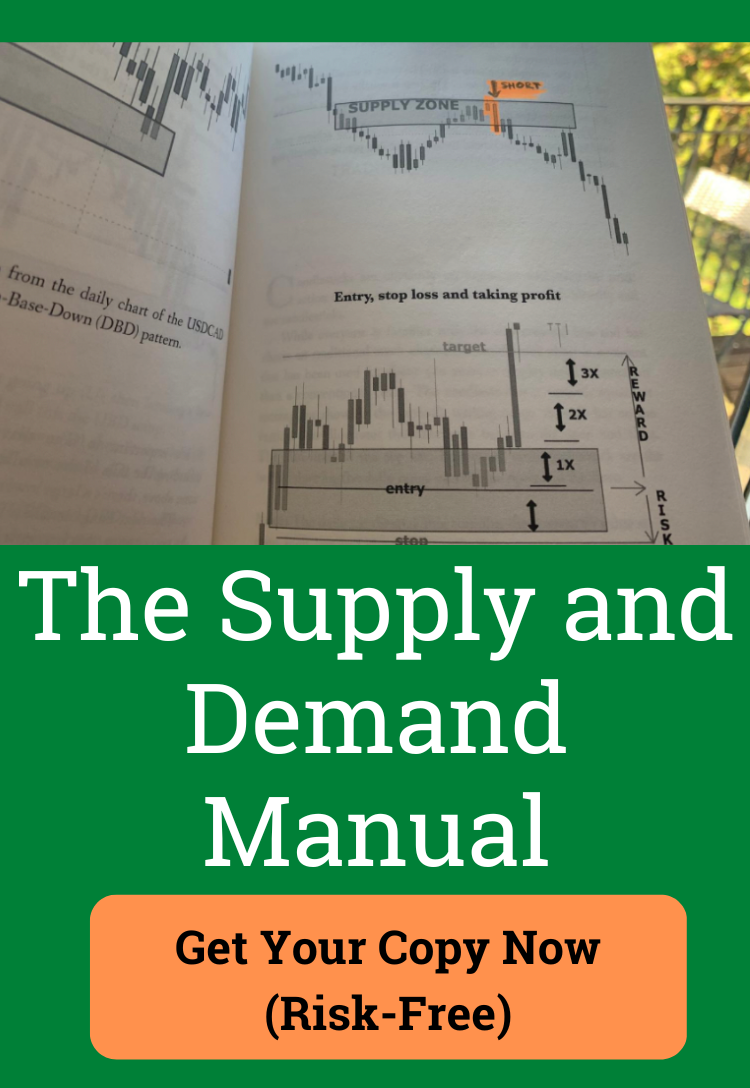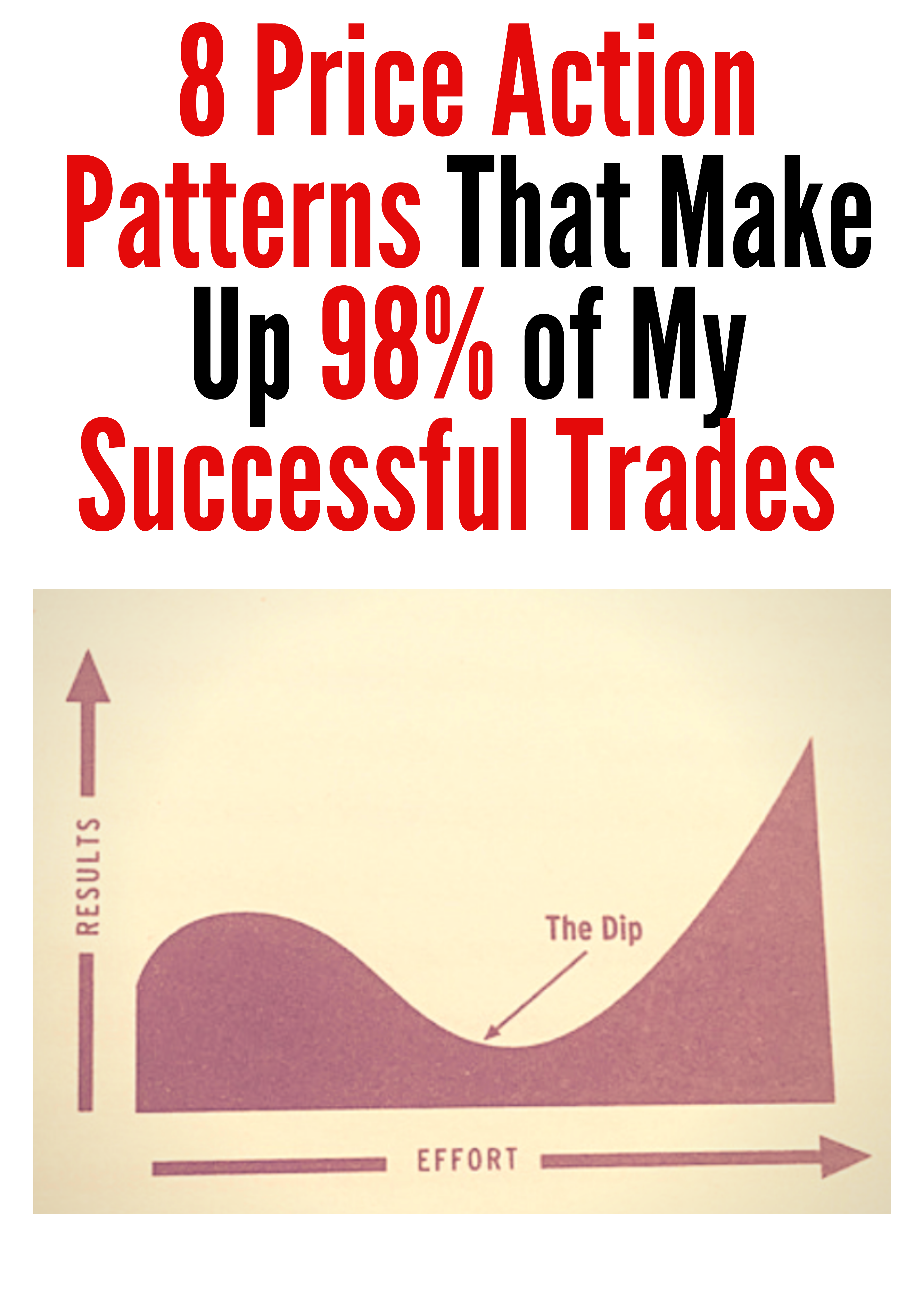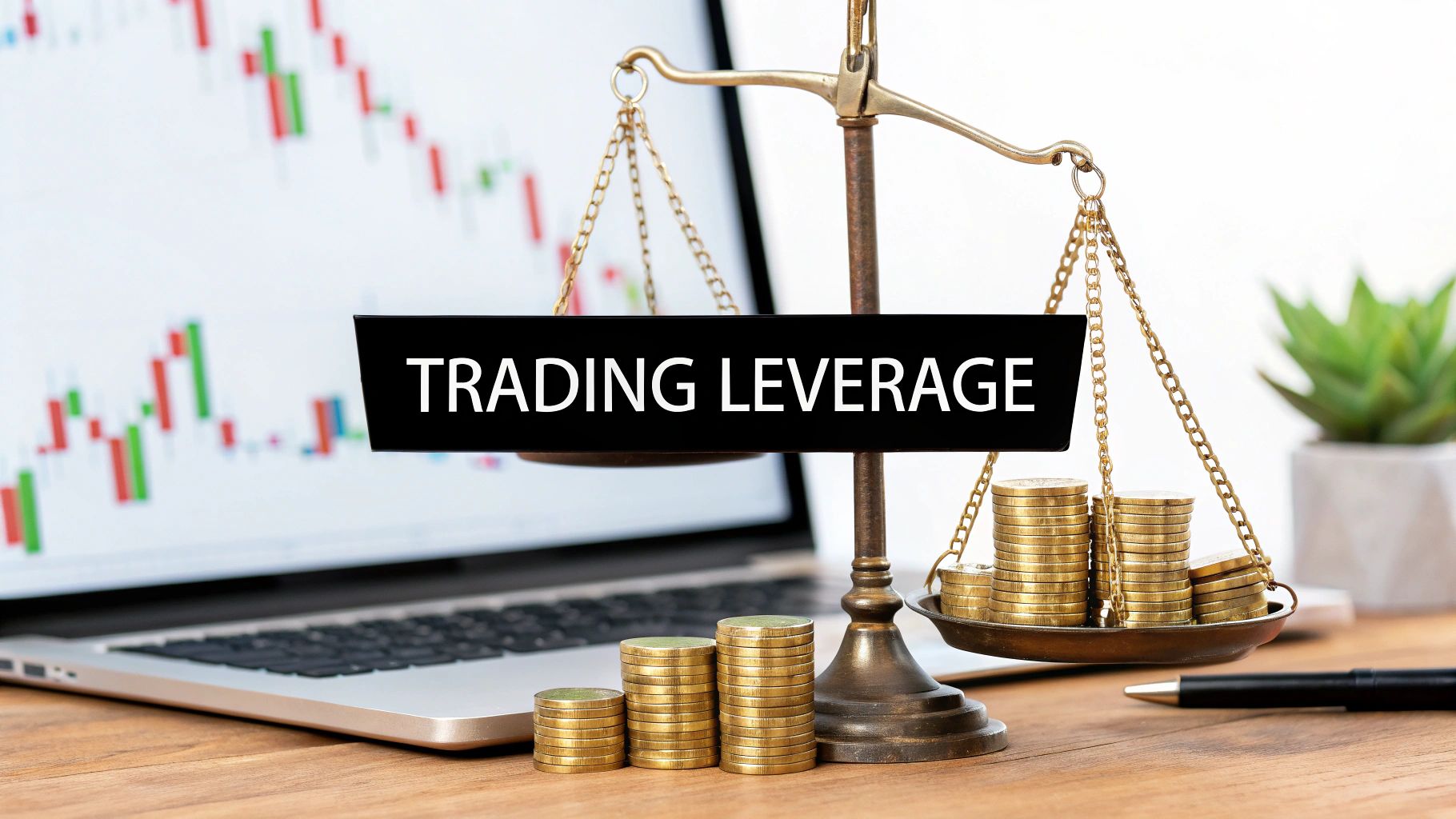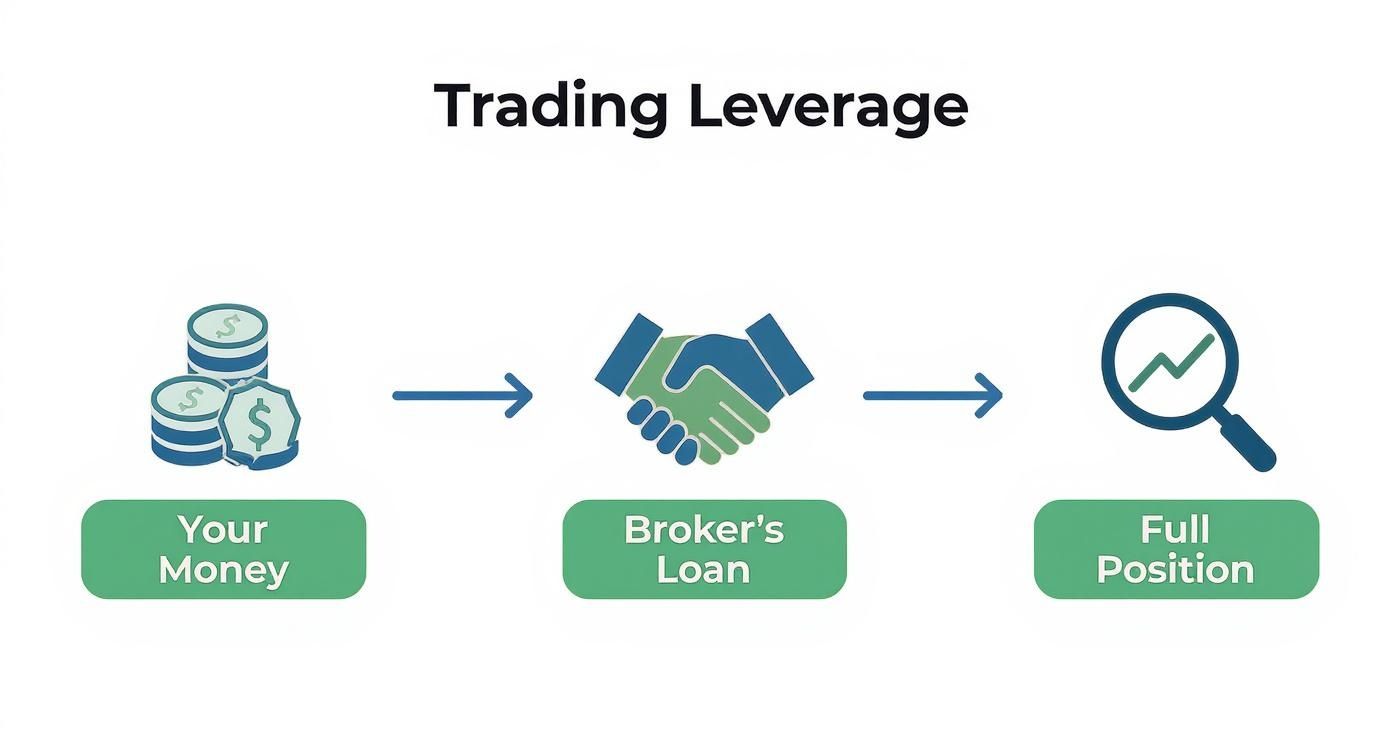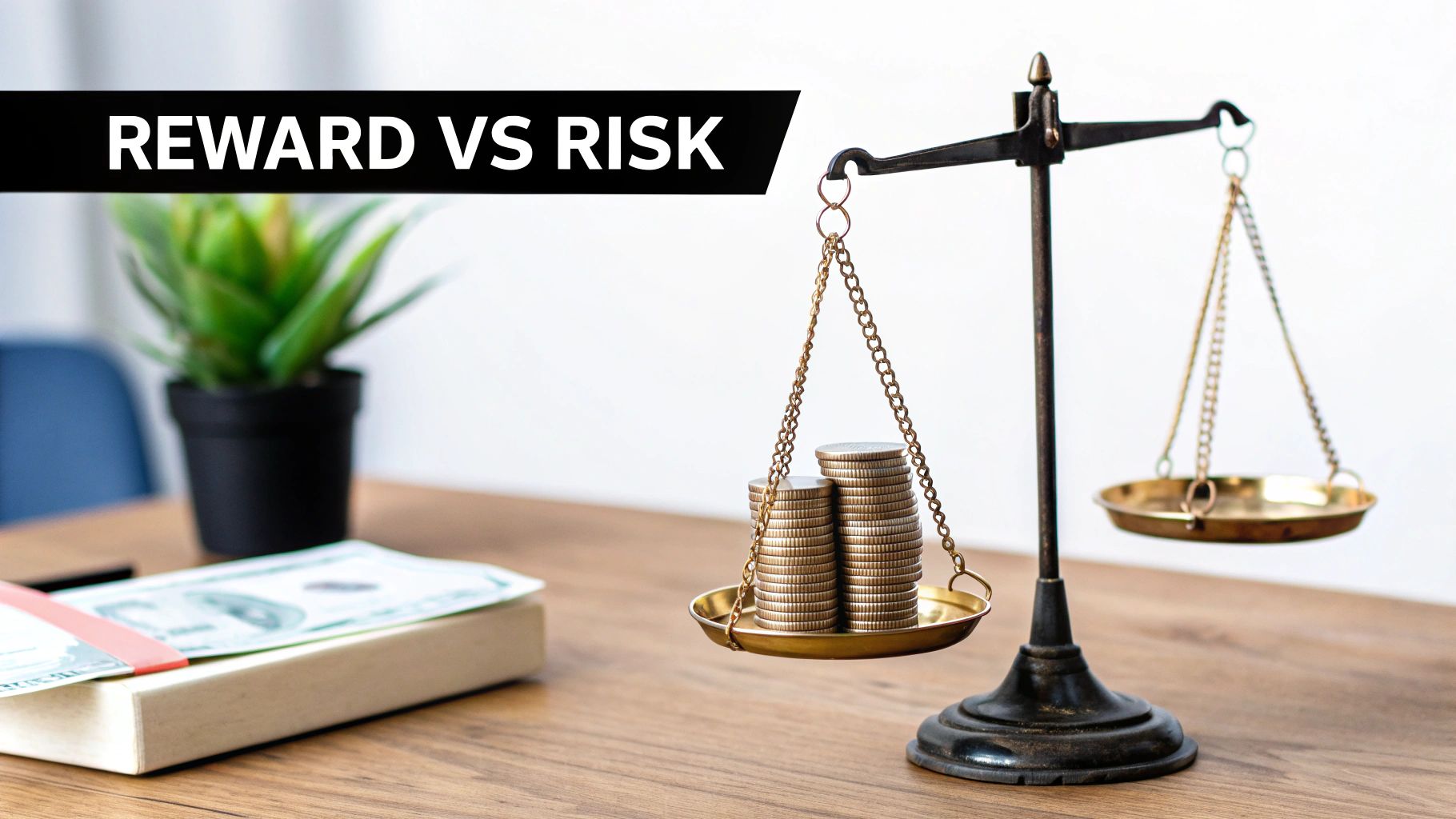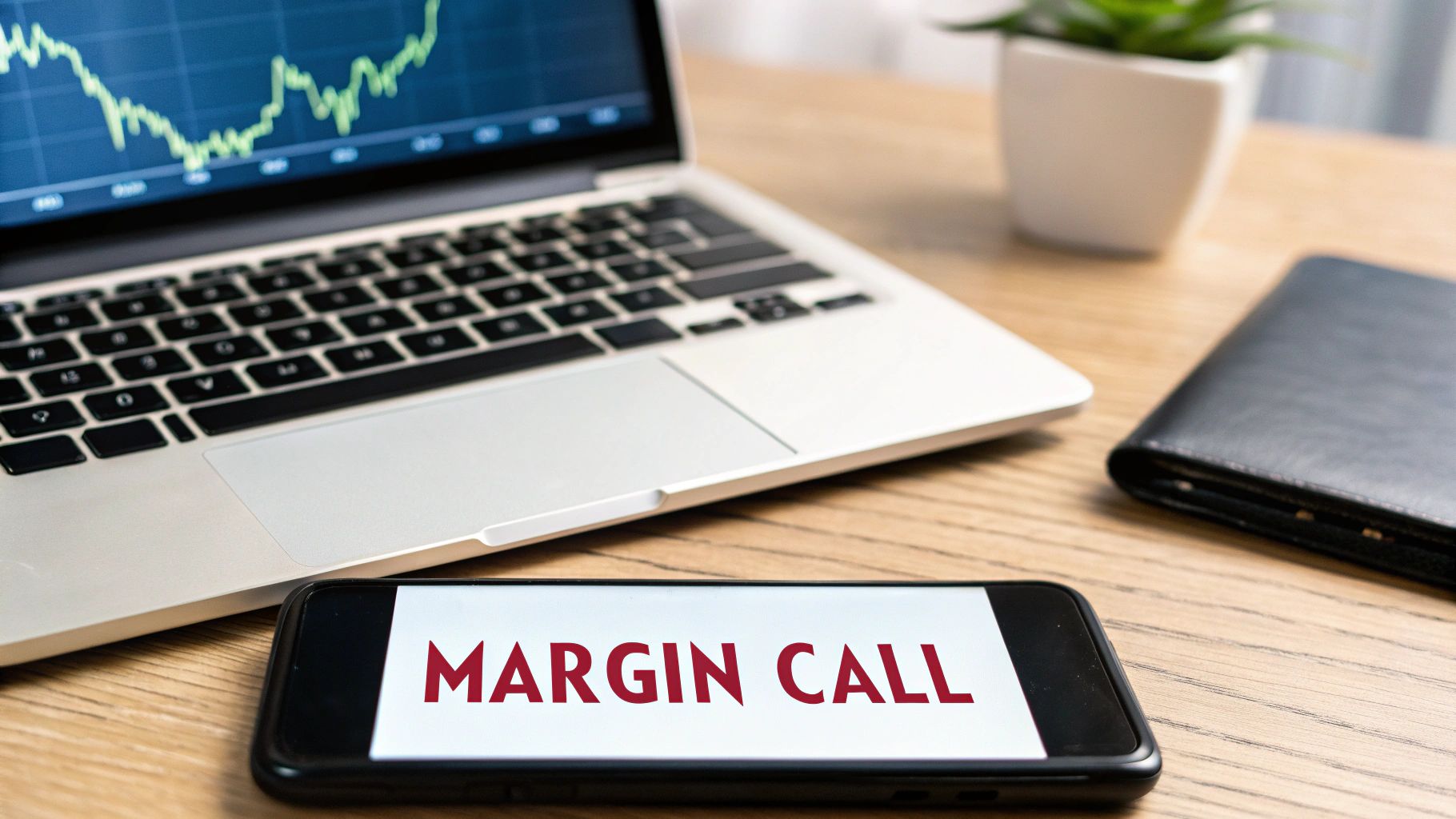What Does Leverage Mean in Trading Explained
Leverage is a way of using borrowed money from your broker to control a much larger trading position than your own funds would typically allow. Think of it as a tool that amplifies your exposure to the market, letting you make a significant trade without tying up all your capital at once.
Of course, this amplification is a two-way street—it magnifies your potential profits and your potential losses in equal measure.
Decoding Trading Leverage
At its heart, leverage is just what it sounds like: using a financial lever to move something heavy. Instead of needing $50,000 in your account to buy a certain amount of stock or currency, your broker might only ask you to put up $1,000 of your own money. This deposit is known as margin.
Your broker then fronts the other $49,000, giving you control over the full $50,000 position. It's a powerful mechanism that gives traders a few key advantages:
- Capital Efficiency: Your money isn't locked into one giant trade. You can spread your capital across different opportunities.
- Greater Market Access: It opens doors to markets that would otherwise demand a huge upfront investment to even get started.
- Higher Return Potential: Even tiny price movements in your favor can turn into substantial gains on your initial margin.
But you have to respect the other side of that coin. That same power means a small market move against you can result in equally magnified losses. To see a great real-world example of how leverage is applied in different financial products, check out this guide on understanding spread betting for traders.
The crucial thing to remember is this: Leverage doesn’t change an asset's fundamental value. It just changes how much of your own money you need to control it, which in turn magnifies the outcome of your trade—for better or worse.
To really get a feel for how this works, let's break down the moving parts of any leveraged trade.
The Core Components of a Leveraged Trade
A quick look at the essential elements that make up any trade using leverage.
| Component | Its Role in Your Trade |
|---|---|
| Your Capital | The initial funds sitting in your trading account. |
| Margin | The slice of your capital the broker requires to open and hold your leveraged position. Think of it as your "good faith deposit." |
| Leverage Ratio | Shown as 10:1, 50:1, etc., this ratio tells you how much larger your position is compared to the margin you put down. |
| Full Position Size | The total value of the asset you're controlling, which is your margin combined with the funds borrowed from the broker. |
These four elements work together in every single trade where you use leverage. Getting comfortable with how they interact is the first step to using this tool effectively.
How Leverage and Margin Actually Work
To really get what leverage means in trading, you have to understand its two crucial parts: margin and the leverage ratio.
Think of margin as your good-faith deposit. It’s the amount of your own cash the broker requires you to put up to open and hold onto a leveraged trade.
The leverage ratio, on the other hand, is what determines just how big of a position you can control with that margin. You'll see this shown as 10:1, 50:1, or even higher. It’s important to know that the broker isn’t just handing you a pile of cash; they are simply fronting the rest of the money so you can access a much larger slice of the market.
A Practical Example of Leverage
Let's walk through a quick example.
Imagine you want to control a $10,000 position in a particular stock, but you only want to tie up $1,000 of your own capital. With a 10:1 leverage ratio, you can do exactly that. Your $1,000 acts as the margin, and the broker effectively covers the other $9,000, letting you command the full $10,000 position.
What this means is that any percentage gain—or loss—is calculated on the total $10,000 value, not just your $1,000 margin. This direct link between your small deposit and the total position size is the key to understanding how leverage magnifies your outcomes, for better or worse. For a deeper dive, our guide on forex basics like margin and leverage offers even more detailed examples.
This little diagram helps visualize how your capital and the broker's backing come together to create your full trading position.
The flow is pretty straightforward: your initial margin is just a small piece of the puzzle, but it unlocks a position many times its actual size.
This dynamic is particularly common with derivative products. In fact, instruments like futures and options are built on high leverage, sometimes requiring margins as low as 8% for an equivalent exposure of $1 million in underlying assets.
The Double-Edged Sword of Leverage
Leverage is easily one of the most powerful tools in any trader's kit, but its power cuts both ways. To really get what leverage means in trading, you have to look at both its incredible potential and its very real dangers. It can be your ticket to huge gains or the fast track to a blown account.
On the one hand, the benefits are what draw people in. Leverage gives you the ability to turn small market ripples into significant waves of profit. It makes your trading capital work much harder for you.
Instead of parking a huge sum of cash in a single trade, you can control that exact same position with just a small fraction of the capital, known as margin. This frees up the rest of your money for other opportunities. It's an efficient way to get more bang for your buck and gain access to markets that might otherwise require a massive upfront investment.
The Clear Advantages of Using Leverage
When used correctly, the upside is undeniable. It can completely change how you approach the markets.
- Amplified Returns: This is the main attraction. A small percentage gain in the market can create a much, much larger percentage gain on your trading capital.
- Increased Capital Efficiency: You can command a large position with a relatively small amount of money. This means your funds aren't all tied up, letting you diversify or jump on other trades.
- Greater Market Access: Leverage opens doors to markets that typically demand a huge investment, which helps level the playing field for retail traders.
The Unforgiving Risks of Leverage
But here's the catch. For every single advantage, there's an equally powerful risk waiting on the other side. The very same mechanic that juices up your profits will magnify your losses with the exact same brutal force.
A small move against your position can wipe out your entire margin in the blink of an eye. This is what leads to the dreaded margin call—an urgent demand from your broker to deposit more funds to cover your growing losses.
If you can't meet the call, your broker will slam your position shut, locking in those losses for you. In the worst-case scenario, you can actually lose more money than you even started with.
Leverage offers no forgiveness for mistakes. It takes a disciplined trading plan and strict risk management to use it effectively without exposing your account to catastrophic failure.
Leverage in Action: A Trade Comparison
To really see the difference, let’s look at how a simple trade plays out with and without leverage. We'll imagine a $1,000 account and see what happens when the market moves 5%.
| Scenario | Without Leverage (1:1) | With Leverage (10:1) |
|---|---|---|
| Initial Capital | $1,000 | $1,000 |
| Position Size | $1,000 | $10,000 |
| Market Moves Up 5% | $50 Profit (5% gain) | $500 Profit (50% gain) |
| Market Moves Down 5% | $50 Loss (5% loss) | $500 Loss (50% loss) |
The numbers don't lie. That 5% market move created a staggering 50% gain or loss on the initial capital when using 10:1 leverage. It's a stark reminder of why this powerful tool demands your absolute respect.
How Leverage Varies Across Financial Markets
Leverage isn't a "one-size-fits-all" tool. Its power, and how much is available, changes dramatically depending on the financial market you're trading in.
Understanding these differences is crucial. What’s considered normal in one arena could be wildly risky in another.
Leverage is probably most famous in the foreign exchange (Forex) market. Here, it’s not uncommon for brokers to offer very high leverage ratios, sometimes 50:1 or even more.
This is possible mainly because major currency pairs tend to be less volatile day-to-day compared to individual stocks. The price movements are tiny, so traders need higher leverage to make those small shifts meaningful. For a deeper dive into how this works, you can explore more about what leverage is in Forex and why it’s so central to that market.
This kind of high-leverage environment is a core feature of the financial system, especially for the big institutional players. While banks often use lower leverage to protect against systemic risk, hedge funds are known to operate with much more. Data from the Federal Reserve shows that hedge fund leverage in the equity markets is consistently strong, which tells you how the pros use this tool to amplify their strategies. You can see more insights on financial sector leverage on federalreserve.gov.
Leverage in Stocks and Futures
When you switch over to the stock market, the landscape changes completely.
Here, leverage is usually accessed through a margin account, but the ratios are far more conservative. Regulations often cap leverage on stocks at around 2:1 for positions held overnight. This reflects the much higher potential volatility of individual companies. A single bad earnings report or unexpected news event can cause a stock's price to swing violently, making high leverage far too dangerous for most.
Finally, you have the commodities and futures markets. In this world, leverage is baked right into the contract structure itself. You aren't borrowing money in the traditional sense. Instead, you're controlling a large contract value with a much smaller deposit, known as a performance bond or margin.
Key Takeaway: The amount of leverage offered in a market is almost always tied to its typical volatility. Less volatile markets like Forex can support higher leverage, while more volatile markets like individual stocks have strict limits to protect traders from catastrophic, amplified losses.
Understanding the Dreaded Margin Call
Most traders remember the first time they saw “Margin Call” flashing on their screen—it feels like your broker’s tapping you on the shoulder with a very firm reminder: time to top up your account. This alert isn’t a suggestion or a casual heads-up. It’s a clear demand: inject fresh capital or watch positions get closed out.
At its heart, a margin call happens when your trade goes south and your original deposit can’t cover possible losses anymore. In plain terms, your account equity dips below what’s called the maintenance margin—the safety buffer your broker insists on keeping.
Think of the maintenance margin as the broker’s own lifeline. Once your losses nibble into that cushion, they’re staring at money they lent you slipping away.
The Anatomy Of A Margin Call
Here’s a down-to-earth example:
- You open a position worth $20,000.
- Your broker requires 25% as the maintenance margin.
- That means your equity must stay above $5,000.
Now imagine the market turns against you. Your account equity sinks to $4,900—just $100 below the threshold. At this point:
- You receive a margin call.
- You’re asked to top up funds fast.
- If you can’t, the broker steps in.
Forced Liquidation: Your broker can sell your positions at the going market rate to protect their loaned capital. You end up locking in those losses, no negotiation, no second chance.
Broader Market Impact
A single margin call can sting, but when many traders get hit at once, it ripples through the entire market. Here’s what usually unfolds:
- Wave of forced sell orders
- Rapid price declines
- More accounts breaching maintenance margins
- Fresh margin calls across the board
This domino effect isn’t just theory. When China’s stock market collapsed in 2015, mass margin calls drove a scramble to sell, turning a correction into a full-blown crash. You can discover more insights on how leverage can turn corrections into crashes on insights.som.yale.edu.
Strategies for Using Leverage Responsibly
Knowing leverage is risky is one thing. Actually managing that risk is what separates professional traders from gamblers. To use leverage responsibly, you have to shift your entire mindset—stop chasing those huge, amplified profits and start obsessing over protecting your capital.
It’s all about treating leverage like a precision tool, not a sledgehammer for making high-stakes bets. Every move needs to be calculated.
Adopt a Defensive Trading Stance
First things first: treat your trading capital like it's the only money you'll ever have. This means you always, always play defense before you even think about going on offense.
- Choose Lower Leverage Ratios: It's tempting to jump straight to 50:1 or 100:1 leverage, but for anyone starting out, that's a recipe for disaster. Stick with a more conservative ratio like 5:1 or 10:1. This gives you room to learn the ropes without risking a catastrophic loss on a single bad trade.
- Implement Strict Stop-Loss Orders: A stop-loss is your non-negotiable safety net. It’s an automatic order that gets you out of a trade at a specific price, putting a hard cap on your losses before they can spiral out of control.
- Calculate Your Position Size Carefully: This is a golden rule in trading. Never risk more than 1-2% of your entire account on any single trade. A dedicated position size calculator is a fantastic tool to help you figure out the exact right amount to trade based on your risk tolerance and stop-loss placement.
Your primary job as a leveraged trader is not to make money but to stay in the game. Effective risk management ensures you have the capital to trade tomorrow.
Since leverage magnifies both your winners and your losers, getting a handle on risk is absolutely paramount. To dive deeper into proven strategies for protecting your capital in volatile markets, check out this excellent guide on Mastering Day Trading Risk Management.
Got Questions About Trading Leverage?
Let's tackle a few of the most common questions that pop up when traders first start exploring leverage. My goal here is to give you quick, straight-to-the-point answers to really cement what we've covered.
Can I Lose More Money Than I Deposit?
Yes, you absolutely can, especially when the market goes wild. It's a sobering thought, isn't it? While many brokers now offer "negative balance protection" to prevent this, you must confirm this is part of your agreement. Never assume.
The best way to sleep at night is to use a hard stop-loss order on every single leveraged trade. No exceptions. This is you, the trader, drawing a line in the sand and telling the market, "This is the absolute most I'm willing to risk on this idea."
What Is a Good Leverage Ratio for Beginners?
There's no magic number, but if you're just starting out, keep it low. Think 5:1 or maybe 10:1. This lets you get a feel for how both profits and losses get magnified, but without risking a catastrophic, account-ending loss while you're still finding your feet.
Once you have a strategy that you can prove is consistently profitable over time, then you can think about slowly, carefully nudging it up. But this has to be done as part of a rock-solid risk management plan, not on a whim.
Is Leverage Just Another Form of Debt?
It's a fair question. While you are borrowing funds, it's not like a typical bank loan. The money is used purely to secure a larger position in the market; it never actually hits your bank account. The "loan" is backed by your margin and is settled the second you close your trade.
The crucial similarity, though, is your liability. You are 100% responsible for any losses you rack up with that borrowed capital. This is exactly why discipline is not just a buzzword in trading—it's your lifeline.
Here at Colibri Trader, we believe in giving traders the real-world education they need to use powerful tools like leverage responsibly. Take our free Trading Potential Quiz to start your journey.


